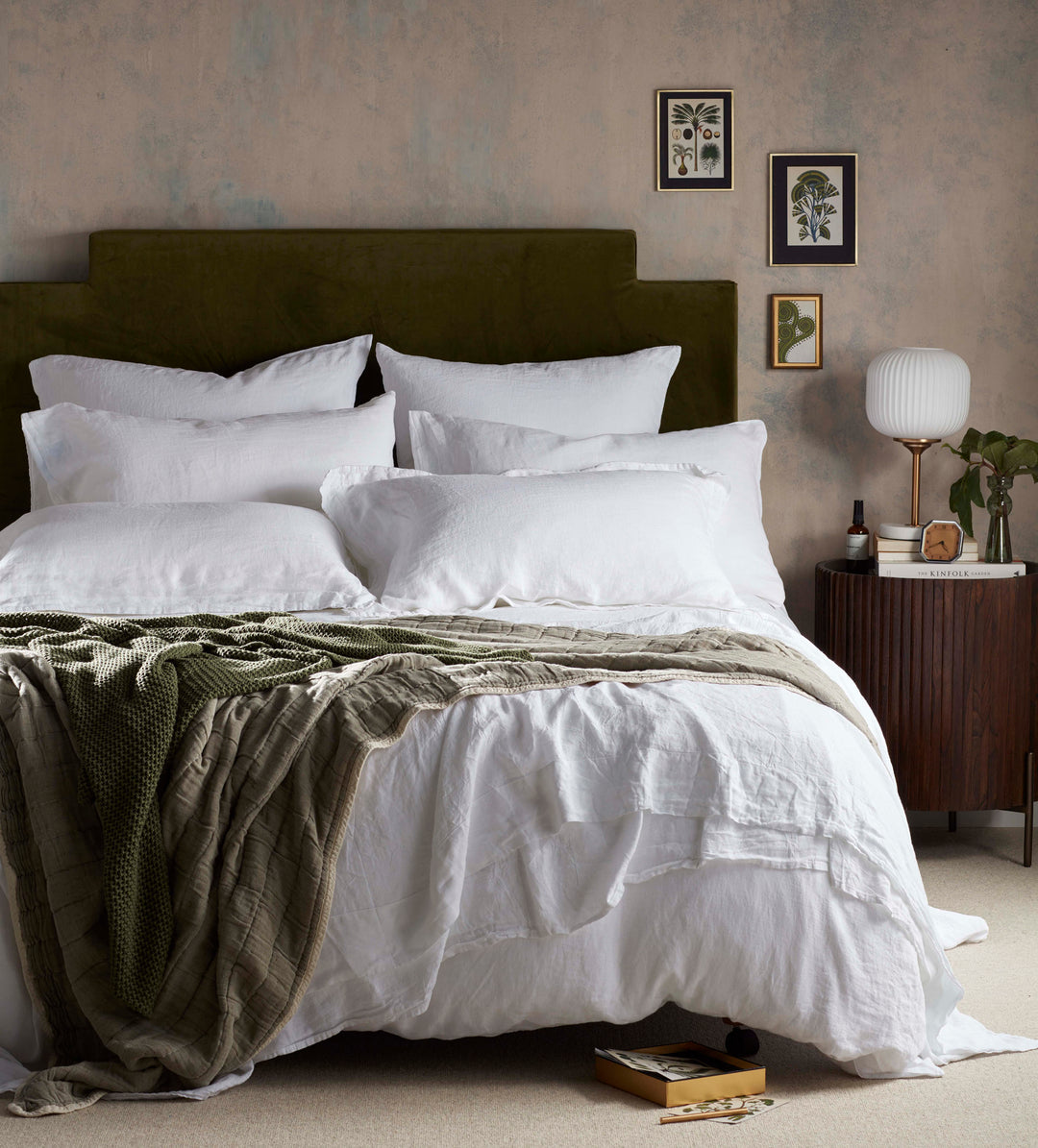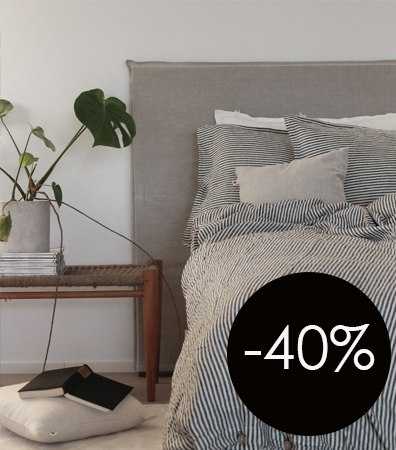Comprehending Bed Linen: The Eco-Friendly Alternative for Comfortable Living
When you consider environment-friendly materials, bed linen often attracts attention for its unique qualities. This natural fabric, made from the flax plant, provides both comfort and sustainability. Its exceptional homes make it an ideal selection for warm weather condition and resilient use. However what really sets linen aside from various other materials? Understanding its origins and benefits can change exactly how you view home textiles. Allow's discover the interesting globe of linen even more.
The Origins of Bed Linen: From Flax to Fabric

Linen, one of the oldest textiles recognized to humankind, has a fascinating journey that begins with the modest flax plant. You might be amazed to discover that this plant thrives in trendy environments, thriving in areas like Europe and components of Asia. Once collected, the flax stalks undergo a procedure called retting, where they're soaked to divide the fibers from the woody parts. After retting, the fibers are brushed and spun right into yarn, all set for weaving.
When you see linen fabric, you're seeing centuries of craftsmanship. The weaving process transforms those spindles of string into the stunning, durable fabric you like. Bed linen has actually been treasured for its all-natural look, making it a favored for everything from apparel to home textiles. Next time you touch bed linen, remember its rich background that connects you to ancient societies and their traditional methods.
The Special Characteristic of Linen
Among the standout features of this exceptional textile is its breathability. When you wear linen, you'll see how it allows air to flow, keeping you cool on warm days. This building makes it an ideal choice for summer garments and bedding.
Linen additionally boasts remarkable moisture-wicking abilities, drawing sweat far from your skin and allowing it to evaporate quickly. You won't really feel clammy, also in moist conditions. In addition, linen is resilient, frequently becoming softer and much more comfortable with each laundry, which indicates it can stand the test of time in your wardrobe.
An additional one-of-a-kind facet is its natural texture; the small irregularities give bed linen a character that enhances your style. Plus, it resists wrinkles much better than lots of other fabrics, so you can enjoy a kicked back yet brightened look without much effort. Welcome linen, and you'll value its comfort and unique appeal.
Environmental Benefits of Bed Linen
When you select linen, you're not just selecting a gorgeous textile; you're additionally supporting lasting production practices. Bed linen's biodegradable and compostable nature makes it a clever option for the atmosphere. Plus, it needs significantly less water to produce contrasted to other fabrics, assisting preserve this precious source.
Sustainable Manufacturing Practices
Although numerous fabrics have significant ecological effects, bed linen attracts attention because of its lasting production techniques. When you select bed linen, you're selecting a textile made from the flax plant, which needs very little water and pesticides. This resistant plant can flourish in inadequate soil conditions, reducing the requirement for chemical fertilizers. Additionally, the entire flax plant is made use of in production, decreasing waste and promoting source performance.
Linen production is usually less energy-intensive compared to various other textiles, as it entails all-natural procedures rather than artificial therapies. By supporting bed linen, you're contributing to a much more lasting textile market that prioritizes eco-friendly practices. Picking linen not just improves your convenience but likewise straightens your worths with environmental obligation.
Compostable and eco-friendly Material
Bed linen's environment-friendly nature prolongs beyond its lasting production; it's also biodegradable and compostable, making it an outstanding option for eco conscious customers. When you select linen items, you're deciding for products that damage down naturally, returning nutrients to the planet. Composting linen can enhance soil, promoting healthy plant growth.
Reduced Water Usage
One of the standout advantages of linen is its low tide intake during growing. Unlike cotton, which requires substantial irrigation, bed linen's flax plant prospers on very little water, making it an extra sustainable choice. You'll value knowing that for every single lots of bed linen produced, considerably less water is required compared to numerous various other textiles. This indicates that choosing bed linen helps preserve essential freshwater sources, which is critical in today's climate. In addition, linen's natural drought resistance permits it to grow in less-than-ideal problems, even more lowering its ecological impact. By deciding for bed linen, you're not simply buying top quality; you're also sustaining a fabric that advertises accountable water usage and adds to a much healthier planet for future generations.
Bed linen vs. Other Fabrics: A Contrast
When you contrast bed linen to various other fabrics, you'll see its exceptional breathability and comfort, making it perfect for warm weather. Plus, linen sticks out for its longevity and longevity, usually lasting longer than several generally made use of materials. As you consider your options, the environmental impact of each fabric will certainly additionally play an important role in your decision.
Breathability and Comfort
Breathability is a crucial consider selecting fabrics for comfort, particularly in warm weather condition. Linen attracts attention amongst materials for its amazing ability to allow air blood circulation. Unlike synthetic materials, which can catch heat and moisture, bed linen's all-natural fibers wick away sweat, keeping you cool and completely dry. When you put on bed linen, you'll discover exactly how it really feels light against your skin, boosting your comfort during hot days.
Cotton is commonly praised for its gentleness, yet it doesn't match linen's breathability. If you prioritize comfort, specifically in summertime, bed linen ought to be your go-to option.
Resilience and Durability
While many materials supply varying levels of sturdiness, bed linen truly stands out in longevity, making it a wise financial investment for your closet. Unlike cotton or synthetic products that may break quickly, linen gets stronger with each laundry. Its all-natural fibers resist fading and fraying, guaranteeing your garments look great in time. You'll discover that bed linen's breathable nature also minimizes wear from sweat and dampness, which can harm various other materials. And also, its capacity to stand up to high temperature levels means it won't diminish easily in the clothes dryer. When you choose linen, you're choosing for a durable material that can manage everyday usage while keeping its beauty. Believe me, your long-term financial investment in linen will pay off with years of stylish, comfortable wear.
Environmental Impact Comparison
Although numerous fabrics contribute to environmental issues, bed linen sticks out for its environmentally friendly qualities. Unlike cotton, which requires massive water sources and chemicals, linen is made from flax, a plant that grows on marginal water and requires fewer chemicals. This indicates you can really feel good about your choice while reducing your carbon impact.
When compared to artificial materials like polyester, linen's biodegradability beams. While polyester can take centuries to decay, bed linen breaks down normally, returning nutrients to the soil.
Choosing bed linen not just promotes lasting farming practices yet also sustains a healthier world. By choosing bed linen over conventional textiles, you're making a mindful decision that benefits both your Go Here convenience and the environment.
Taking care of Your Bed Linen Textiles
To ensure your linen fabrics continue to be in wonderful condition, you'll wish to comply with some straightforward care standards. Wash your bed linen in cold water on a gentle cycle to avoid it from reducing or losing its form. Stay clear of utilizing bleach, as it can harm the fibers. Instead, choose a light detergent that's free from rough chemicals.
When it comes to drying out, air drying is finest. If you make use of a clothes dryer, select a low heat setting and remove the products while they're still a little website here damp to reduce creases. Iron the bed linen while it's still damp for easier handling, or heavy steam it to keep it looking crisp.
For storage, keep your linen in a cool, dry location. Prevent straight sunlight to stop fading. With these basic techniques, your bed linen textiles will keep their beauty and last for several years, making them a lasting enhancement to your way of life.
Integrating Linen Into Your Home Decoration
Taking care of your linen textiles not just protects their high quality yet also opens up a world of opportunities for incorporating them right into your home style. You can begin small by adding bed linen throw pillows to your sofa, instantly raising the area with appearance and heat. Consider linen curtains that filter sunshine magnificently, developing a soft, airy environment in any space.
For an extra rustic look, try making use of linen table linens or runners during meals; they add a stylish touch and are simple to tidy. If you're really feeling adventurous, mix and suit various bed linen colors and patterns to develop a special, split effect.
Do not ignore bed linen coverings-- drape one over a chair or your bed for a welcoming feel. By thoughtfully incorporating bed linen into your decoration, you boost both comfort and style, making your home a serene retreat.
The Future of Bed Linen in Sustainable Living
As customers significantly focus on sustainability, bed linen emerges as a frontrunner in green fabrics. Its manufacturing makes use of much less water and chemicals compared to standard cotton, making it a more environmentally liable choice. As you look in the direction of a lasting future, incorporating linen into your closet and home can substantially reduce your carbon impact.
Ingenious brands are currently focusing on sustainable methods, from using organic flax to executing circular economic situation concepts. You'll find that linen's resilience suggests it lasts longer, decreasing the requirement for regular substitutes.
Moreover, as even more people welcome minimal lifestyles, bed linen's ageless allure and versatility will keep it relevant. By choosing bed linen, you're not simply selecting convenience; you're likewise sustaining lasting practices.
In the upcoming years, the demand for linen is expected to grow, solidifying its location in a much more eco-conscious world. So, consider making linen a staple in your lasting living trip.
Frequently Asked Concerns
Is Bed Linen Ideal for Individuals With Allergies?
Yes, bed linen's all-natural fibers are hypoallergenic, making it ideal for individuals with allergic reactions. Its breathable nature helps in reducing moisture and microorganisms accumulation, adding to a much healthier resting environment. You'll likely locate it risk-free and comfortable.
Can Linen Be Dyed Quickly?
Yes, you can color linen quickly. Its all-natural fibers take in dyes well, enabling lively shades. Simply make sure you utilize the best color kind and adhere to proper methods to accomplish the wanted outcomes without harming the fabric.
Exactly How Does Bed Linen Contrast in Resilience to Cotton?

What Weight of Linen Is Ideal for Summer Season Clothes?
For summertime garments, light-weight linen around 4 to 5 ounces per yard is ideal. It maintains you trendy, breathable, and comfy in heat (Linenshed). You'll value how it drapes and moves with you easily

Can Linen Be Used for Outdoor Furnishings?
Yes, you can utilize bed linen for outside furnishings. It's breathable and durable, making it a fantastic choice for warm weather condition. Just make certain to select a treated version to stand up to the aspects and preserve its look.
Verdict
Incorporating linen into your life not only enhances your convenience however also supports an extra lasting future. With its special properties and marginal ecological effect, linen is a wise choice for your home décor and way of life.
Bed linen's naturally degradable and compostable nature makes it a wise option for the environment. By including bed linen into your home, you're not simply appreciating its convenience and sturdiness; you're likewise helping and sustaining eco-friendly techniques create a healthier planet. The Future of Bed Linen in Sustainable Living.
